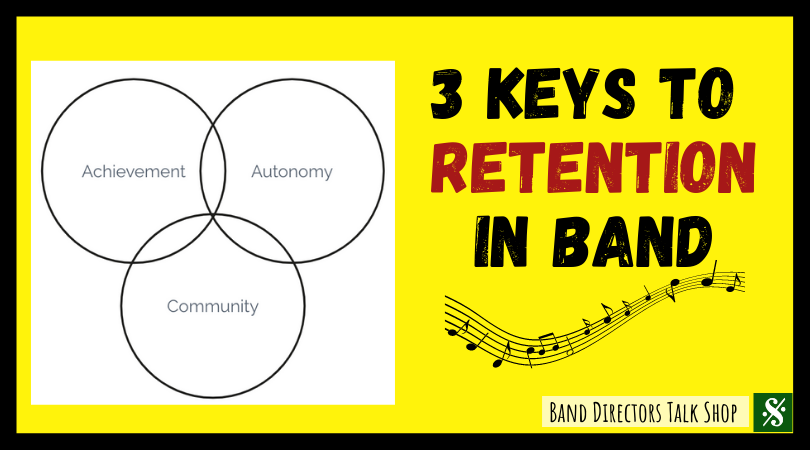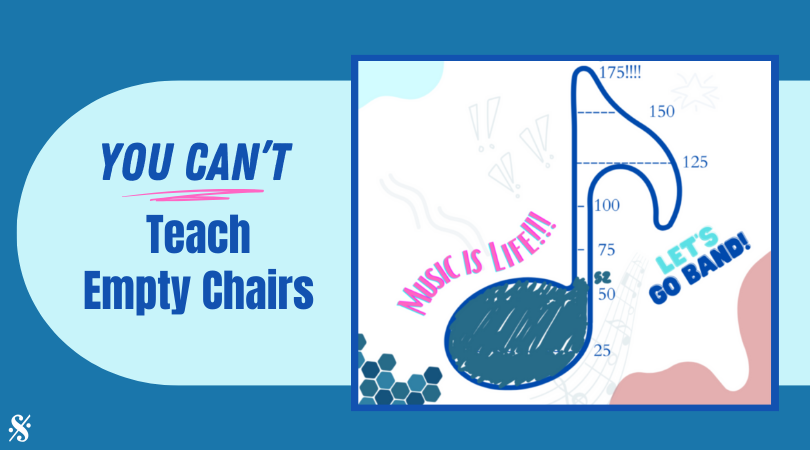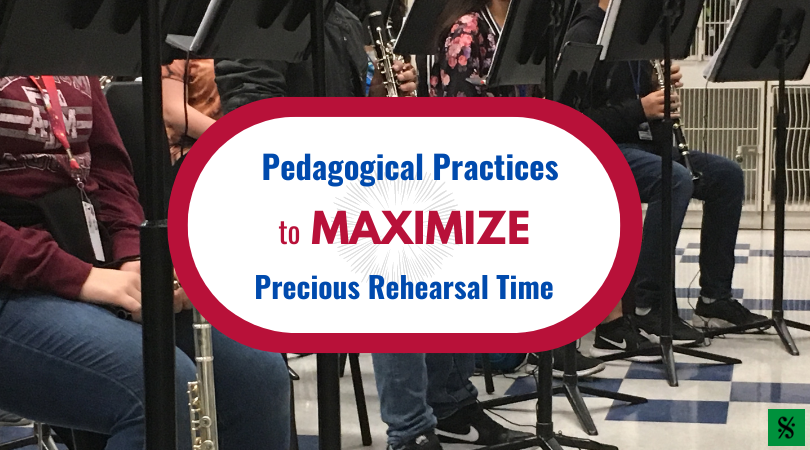Have you ever had that hunch that a student is falling off the bandwagon? In keeping the past two years in mind, we know now more than ever that intrinsic motivation plays a pivotal role in student retention. Success breeds success— achievement, autonomy, and community are the ultimate retention tools. They are a direct reflection of our classroom environment and pedagogy.

This article focuses on tips and suggestions to make your band room a contagious and engaged learning environment that students will want to be part of for years to come.
There are generally three reasons a student may want to quit band:
- Achievement: They do not believe in their capability for growth
- Autonomy: They cannot replicate success in or outside of class, or
- Community: They are not finding belongingness in the band room

Reason #1: Achievement
The most important thing for students to realize is that deliberate practice fosters improvement and that their abilities can grow over time. Our youngest band members need concrete procedures for practicing that are reinforced in every lesson. The most successful practice techniques require students to utilize isolation and repetition for fluency.
- Say it, Shadow it, Play it! — The first line of defense for practicing any new exercise. Students say the letters and finger through the exercise without blowing before playing it in full. This is an excellent first practice strategy for beginner classes.
- Practice Boxes — Box off (isolate) and perform (repeat) a small portion of difficult music at least three times. If there are particularly difficult note changes or rudiment combinations, students may circle smaller concepts within the box.
- Play it Backwards — Early finishers during independent practice time can attempt to perform an exercise backward. This reinforces the same rhythmic relationships and fingering/sticking combinations in a different light and effectively doubles the number of your teaching materials!
- Metronome Challenge — Provide a check chart of metronome tempos and measure numbers you would like your students to practice. With each successful repetition of a phrase, students check off the chart.
- Practice-A-Thon — Have students secure sponsors to donate a penny, quarter, nickel, or dime per minute of practice to a cause of your choice. This could be for your band itself or a cause meaningful in your community. Students should tally their practice minutes at the end of the month. Those that create a practice habit will realize the importance of slow and consistent skill-building.
Reason #2: Autonomy
Achievement is directly related to competence. Competence is either conscious or unconscious— rather, are students able to detect common errors on their own? Our goal is to help students progress to a point of unconscious competence: the point at which performing a skill becomes automatic. Self-assessment is a critical piece in fostering student competence.
- Label the keys, valves, and sticks of your musicians with tape and a number.
- Mini locker-type mirrors allow students to monitor their embouchure and hand position.
- Straws are an excellent way to teach articulation. They teach the angle of lips and proper teeth alignment. Teach your students that the angle a straw falls at is the angle the air is coming out of their mouth.
- Have brass and flute students hold a tissue in front of their mouthpiece to visualize their velocity of air.
- Provide ample opportunity for students to record themselves. Their ears are their best teachers.

Reason #3: Community
Ensuring that all learners feel belongingness will grow your artistic community. It is important to get a sense of what your band currently values before knowing where you would like to be.
First, anonymously survey your students with these sample questions:
- How do you feel when you are in the band room?
- Why did you join band? What makes you stay a band member?
- What concept came most difficult for you? What made that skill become easier?
Second, compare your state-reported ethnicity data with your band program’s numbers. This information is often found on your school’s student database. Truly do your homework and determine the percentages!
Do the demographics of your band match the demographics of your building? If your answer is no, your first step is knowing exactly who needs to be represented in your ensemble. The second step is figuring out what is keeping them from your group.
It is important to program repertoire that reflects the cultures and values of your ensemble. If you are using a method book as your sole curricular resource, the best way to quickly solve the problem is to research songs from your students’ cultures and make a packet. This is going to look different in every district— perhaps even every building. Order them appropriately for your curriculum. Add annotations to help students with notes and rhythms. Most importantly, add a blurb about where the song comes from and what it means to the people who perform it. This is just one way to show students that identity matters in music-making.
Recruitment
You do all of the paperwork, planning, and outreach with your incoming cohort, but students see them in the hallways, at recess, and in the community. Remind your students that recruitment time is coming. The conversations they have with incoming students are more important than any assembly and petting zoo. An extra degree of trust comes from students seeing other students succeed.
- Invite faculty members who once played an instrument to sit in on band rehearsals. They will be surprised how much they remember!
- Encourage faculty members to share their musical experiences with students through a “How Am I Musical” poster outside of their room.
- Consider a specially geared recruitment presentation in your self-contained and ENL classrooms.
- Exit survey students and families who choose to drop.
- Allow students the option to try another instrument before quitting.
- Orchestra and chorus are not our enemies. Other ensembles may actually be that student’s home! Your colleagues will repay the favor.
Conclusion
Intrinsic motivation is truly the best form of advertisement for your program. Achievement, autonomy, and community are the three pillars of intrinsic motivation that keep students playing. Weakness in any area is often the reason a child quits band. If you get that 6th sense about a student on the verge of quitting, consider which pillar they are most lacking.
Nicole Mihalek Rode is the Director of Elementary Bands and Assistant High School Band Director in the East Rockaway School District on Long Island, NY. She holds degrees in Music Education (B.M. and M.M.) and a Certificate in Special Music Education from The Crane School of Music at SUNY Potsdam. She has presented on Recruitment and Retention at the NAfME All-Eastern & New York All-State Conferences. Rode is a Quarterfinalist for the 2022 GRAMMY Music Educator Award.




Leave a Reply
You must be logged in to post a comment.